

Why Makerspaces Give Kids Space to Fail, and Why That’s a Good Thing. Maker Space In Education Series… 10 Sites To Start Making In The Classroom. Welcome back and I sure hope you enjoyed the last article of 20 Reasons for Maker Space in Education.
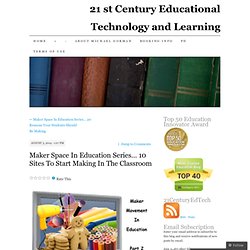
I hope you enjoy this post as I highlight 10 sites to possible help you to get Making in the classroom… even if in the smallest way! I encourage you to send me information and resources you think help with this idea, as I am also Making time to learn. First, to ensure you do not miss one of these valuable posts or other resources covering PBL, Digital Curriculum, Web 2.0, STEM, 21st century learning, and technology integration please sign up for 21centuryedtech by email or RSS. As always, I invite you to follow me on twitter (@mjgormans).
Libraries As Makerspaces and a Makerspace Information Blitz. FryskLab I spent most of Monday afternoon in two sessions about makerspaces: first, on teaching teens how to fail by two groups of librarians, one from the Free Library of Philadelphia and the other from the Denver Public Library.
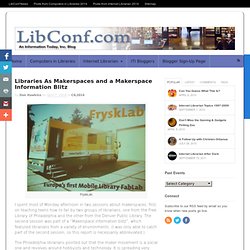
The second session was part of a “Makerspace information blitz”, which featured librarians from a variety of environments. (I was only able to catch part of the second session, so this report is necessarily abbreviated.) The Philadelphia librarians pointed out that the maker movement is a social one and revolves around hobbyists and technology. It is spreading very rapidly. Makerspace Resources. All the Makerspace resources you could hope for (and more) I first started learning about the Maker Movement in education and makerspaces in late 2013.
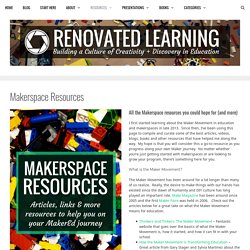
Since then, I’ve been using this page to compile and curate some of the best articles, videos, blogs, books and other resources that have helped me along the way. My hope is that you will consider this a go-to resource as you progress along your own Maker journey. No matter whether you’re just getting started with makerspaces or are looking to grow your program, there’s something here for you. InventiveLabs. 3 Key Qualities for a School Makerspace. Over the past year I had the privilege of leading a team to create makerspaces in 15 high schools around the Bay Area.
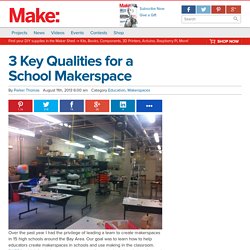
Our goal was to learn how to help educators create makerspaces in schools and use making in the classroom. DARPA, which funded our program, eventually wanted to take what we learned and create makerspaces in 1,000 schools. While our DARPA funding ended in December, we believed so strongly in the benefits of these spaces that we continued to support our pilot schools until the end of the year. This was particularly rewarding work. Most of us have enjoyed watching someone’s eyes light up at Maker Faire, but listening to a high schooler describe his or her first open-ended project was very powerful. Every space in our program was different.
Process. Maker Ed's Resource Library. » Become a Sponsor Disclaimer: Maker Ed’s online Resource Library contains links to third-party organizations, companies, and commercial products.
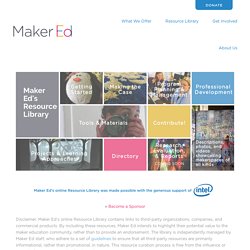
By including these resources, Maker Ed intends to highlight their potential value to the maker education community, rather than to provide an endorsement. The library is independently managed by Maker Ed staff, who adhere to a set of guidelines to ensure that all third-party resources are primarily informational, rather than promotional, in nature. Resources for Creating a Makerspace.
Are you ready to create your own Makerspace?
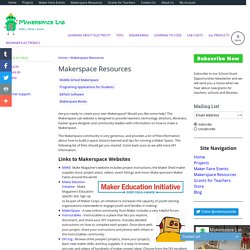
Would you like some help? The Makerspace Lab website is designed to provide teachers, technology directors, librarians, hacker space designer and community leaders with information on how to make a Makerspace. The Makerspace community is very generous, and provides a lot of free information about how to build a space, lessons learned and tips for running a Maker Space. The following list of links should get you started. Come back soon as we add more DIY information. Starting a School Makerspace from Scratch. With the National Week of Making behind us, you might be ready to start a makerspace in your school -- but not know where to start.

Will purchasing a costly 3D printer and the latest robotics kit ensure learning and maker success? What are some steps to starting a successful makerspace from scratch? Step 1: Immerse Yourself in Maker Education Before you can build your own community of makers, you need to join one! Immerse yourself in makerspaces by joining a summer maker camp like Exploratorium's Tinkering Fundamentals or the virtual Camp Google for cheap and easy STEM ideas, but most importantly: make stuff! Step 2: Get Others Involved. Digital Storytelling - Makerspace for Education. 3D Printing and Design - Makerspace for Education. Green Screen Technology - Makerspace for Education. The NMC Horizon Report: 2018 Higher Education Edition. Learning in the Making A Comparative Case Study of Three Makerspaces Sheridan 14. Social justice and out‐of‐school science learning: Exploring equity in science television, science clubs and maker spaces. What is a Makerspace? Is it a Hackerspace or a Makerspace?
Why the 'Maker Movement' is Popular in Schools. The maker movement is a global, DIY movement of people who take charge of their lives, solve their own problems and share how they solved them.
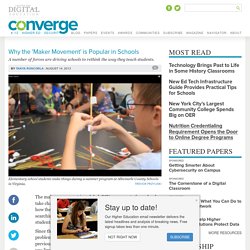
And it's growing in schools that are searching for more authentic learning experiences for their students. Since the beginning of time, people have made things to solve problems and otherwise improve their quality of life. But previously, the amount of exposure individual projects received was limited. Now the Internet has driven projects into the limelight. "These things that used to be isolated are now shared widely," said Sylvia Libow Martinez, president of nonprofit education technology organization Generation YES and co-author of the book Invent to Learn. She shared an example of how this global movement works. From kindergarten to second grade, students traditionally make things with playdough, legos and other objects.
And parents have been telling Libow Martinez that something needs to change. The maker movement: A learning revolution. By Sylvia Martinez and Gary Stager 7/21/2014 Topics: Maker movement, Project-based learning The impulse to create is one of the most basic human drives. As far back as the Stone Age, we were using materials in our environment to fashion tools for solving the problems we encountered.
And in the millions of years since then, we have never stopped creating. In fact, the rise of civilization is largely defined by the progress of technology of one kind or another. Today, the availability of affordable constructive technology and the ability to share online has fueled the latest evolutionary spurt in this facet of human development. Defining Makerspaces: What the Research Says. Recently, I had the unfortunate experience of dealing with criticism.
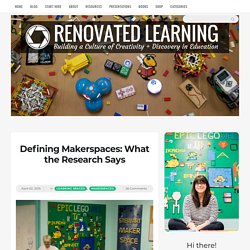
I was told (not to my face) by a visitor to our school that our library makerspace is not a “real makerspace”. This same person stated that our woodshop is a “real makerspace” because it has power tools. She suggested that I “do some research” on what makerspaces actually are. Feeling personally insulted aside, what bothers me most about this statement is the concept that some makerspaces are more valid than others and that a makerspace is solely defined by the tools it contains. How Makerspaces in Schools Help Students Learn to Code. Computer science has taken a priority slot for K–12 teachers, as experts forecast a majority of jobs will incorporate some kind of coding skills or computational thinking by as early as 2020.
One way that schools are engaging students is by introducing coding activities in makerspaces, where students can use the creative culture to start establishing the building blocks of computational thinking. Authentic learning in a makerspace / Makerspaces / Future-focused learning / Teaching. Taupaki School principal, Stephen Lethbridge, and students talk about how they solved real problems in their school during their makerspace learning.
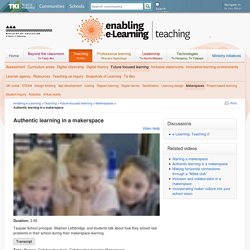
Stephen Lethbridge: So the maker movement in schools for me is about authentic learning, finding real-world problems to help get across concepts and understandings of how the world works. A group of our kids have come up with an innovative problem to solve our litter situation where we’ve had litter problems around the school.
We’ve tried all sorts of things to, you know, alleviate that problem – let’s take the rubbish home, let’s do some recycling, but there still seems to be litter around everywhere. So some children, a group of 7, 8, and 9 year olds decided to flip the problem. Instead of it being a litter problem with the people, let’s make the rubbish bin more attractive to use. Makerspace for Education - Home. Getting to Know the Makerspace Movement in Education. Makerspaces go digital: 6 options for the blended classroom. Makerspaces are a wonderfully interactive, highly creative and increasingly valued part of classrooms in the technology age.
There is literally a wealth of inspiration, guidance and ideas on the web from how to start a makerspace, to complex long-term project ideas and everything in between. What makes Makerspaces so attractive is that they are accompanied by images of students getting “their hands dirty”, experimenting and tinkering in the real-world, and getting out from behind the screen. A Librarian's Guide to Makerspaces: 16 Resources. "There were more than 135 million adult makers, more than half of the total adult population in America, in 2015. " What is a makerspace? You’ve no doubt been hearing that word more than a few times over the past several years. Makerspaces, also called hackerspaces, hackspaces, and fablabs, are collaborative spaces where people gather to get creative with DIY projects, invent new ones, and share ideas. Since the first official makerspace convened six years ago in a library in upstate New York, libraries have remained an ideal setting for makerspace events across the country.